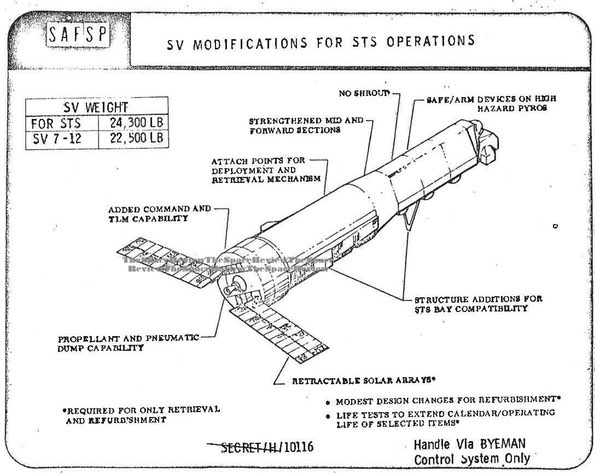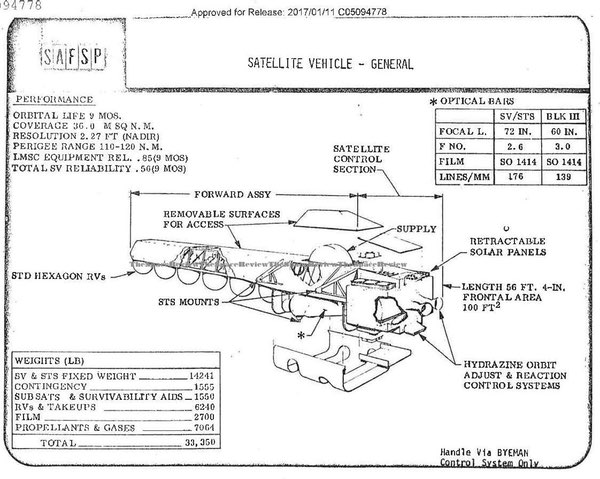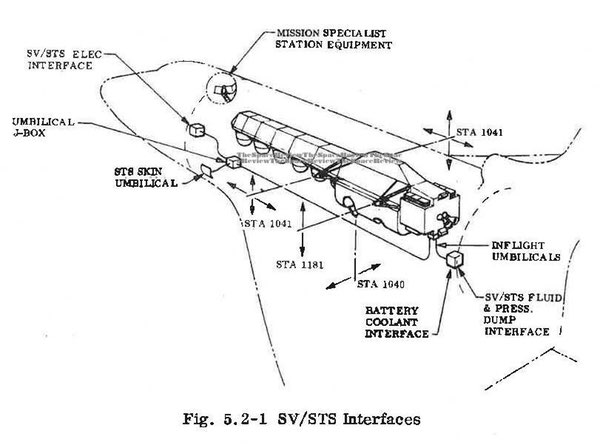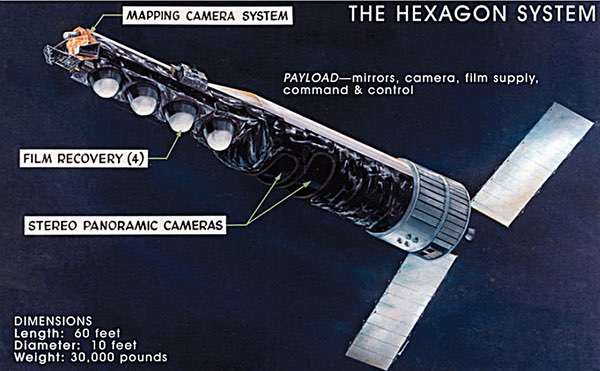
Black ops and the shuttle (part 1)On-orbit servicing and recovery of the HEXAGON reconnaissance satelliteby Dwayne Day
|
| The space shuttle was more than simply a replacement for the Titan III. The shuttle offered many opportunities for improving the HEXAGON’s design. |
Twenty years earlier, the secretive National Reconnaissance Office (NRO) that operated America’s fleet of intelligence satellites evaluated the possibility of doing this kind of mission on a regular basis with the largest reconnaissance satellite then in the inventory, the schoolbus-sized HEXAGON. The NRO and its contractors studied refurbishment and resupply of satellites in orbit, as well as recovery and refurbishment on the ground, considering the value and the drawbacks—and, most importantly, the costs—of resurrecting expired intelligence spacecraft.
This was the first of many studies over the next decade initiated by the NRO to evaluate adapting its various intelligence satellites to use the Space Transportation System. Much of the history of the NRO’s involvement in the space shuttle program remains classified. But many new details are emerging about this period and particularly the NRO’s largest, and most important spacecraft at the time.
 A minimum-modification version of the HEXAGON reconnaissance satellite for launch in the space shuttle. |
The National Reconnaissance Office’s HEXAGON satellite replaced the venerable CORONA satellite that operated from 1960 until 1972. HEXAGON dwarfed its predecessor, and when it first showed up at Vandenberg Air Force Base in California it earned the nickname “the big bird.” In fact, the length of the shuttle’s payload bay had been dictated by the requirement to carry the HEXAGON, although the shuttle’s bay was 4.6 meters wide, compared to the 3-meter diameter of the HEXAGON.
Each spacecraft was equipped with two powerful and sophisticated rotating cameras that scanned the ground below. Film traveling at high speed through the cameras recorded large amounts of territory in each image at a ground resolution better than two feet (0.6 meters). The spacecraft had four reentry vehicles and, when each one filled with film, it was ejected and reentered the atmosphere to be caught in mid-air by a C-130 aircraft. After the first launch in June 1971 atop a Titan III rocket, the NRO launched three more in 1972 and another three in 1973. Although the exact cost of the satellites remains classified, they were not cheap, and they were de-orbited after missions lasting only a few months.
| The most radical concept was for on-orbit servicing and resupply of the HEXAGON. For the Hubble Space Telescope this later proved to be a complex task requiring multiple spacewalks. But Hubble was relatively straightforward compared to the HEXAGON. |
In 1973, the NRO had its HEXAGON contractors undertake a study of adapting the HEXAGON to use the space shuttle. The contractors included Lockheed, which built the spacecraft; Perkin-Elmer, which built the camera system; and McDonnell Douglas, which built the Satellite Reentry Vehicles (SRV). The contractors evaluated multiple options. The most basic option was a minimal-modification HEXAGON that would have few changes from the version launched on the Titan III, but would be adapted for the shuttle’s payload bay. This included internal strengthening and the addition of new mounting points along the sides of the spacecraft, as well as a tripod mounting between the second and third SRVs that connected to the bottom of the shuttle’s payload bay. Other modifications included adapting the HEXAGON’s communications system so that the shuttle crew could interact with it.
The space shuttle was more than simply a replacement for the Titan III. The shuttle offered many opportunities for improving the HEXAGON’s design, and the study evaluated those as well. The contractors looked at various iterations of the HEXAGON design, anywhere from four to up to ten SRVs, and changes in the overall configuration of the spacecraft. These included changing the location of the film supply canisters and repositioning the cameras.
 A highly modified version of the HEXAGON spacecraft to take advantage of the shuttle's larger payload bay compared to the Titan III rocket. This would have allowed carrying six film reentry vehicles instead of the standard four. |
The most radical concept was for on-orbit servicing and resupply of the HEXAGON. For the Hubble Space Telescope this later proved to be a complex task requiring multiple spacewalks. But Hubble was relatively straightforward compared to the HEXAGON. Hubble’s instruments were all located at one end of the spacecraft and thus Hubble could be attached to the payload bay at that end; the astronauts spent most of their time removing and replacing instruments in one section.
HEXAGON would have been far more complex to service. Not only did it require refueling in orbit, it also required new film and new SRVs. The contractors proposed a servicing method whereby the HEXAGON would be secured horizontally above the shuttle’s payload bay. From that position, the entire forebody of the spacecraft with the film supply canisters and the structure that held the SRVs would be rotated out of the way and down, and replaced with a new forebody containing loaded film supply canisters and new SRVs. At the same time, the rear end of the spacecraft, which contained the fuel supply and power system, would be serviced with a rotating tool kit that could provide replacement units. It would have been a highly complex procedure. What is unclear is how the new film would be re-threaded through the camera and to the new SRVs.
| Somewhat surprisingly, although the NRO did not choose to redesign the HEXAGON for recovery and refurbishment at this time, the requirement to do so was still incorporated into the space shuttle’s design. |
Because of the complexity of this resupply and refurbishment, the contractors recommended that the best course of action would be to use the shuttle to recover spent HEXAGON satellites in orbit and bring them back to Earth for refurbishment on the ground. What the contractors also recommended was that the NRO develop a shuttle-optimized HEXAGON, taking advantage of the greater width afforded by the shuttle’s payload bay compared to the diameter of the Titan-34D. This optimized HEXAGON would have retractable solar arrays and a shorter and wider power and propulsion system at the rear. The film supply canisters, instead of being mounted between the camera system and the rest of the spacecraft, would be moved forward and up above the cameras. These changes would have shortened the rear part of the spacecraft, enabling a longer forebody equipped with six SRVs instead of the four SRVs on the currently operational version. One intriguing proposal was for a Block III version, sort of “HEXAGON-Light,” which would have had less-powerful cameras and slightly lower resolution, trading this capability for other benefits.
Somewhat surprisingly, although the NRO did not choose to redesign the HEXAGON for recovery and refurbishment at this time, the requirement to do so was still incorporated into the space shuttle’s design. A 1973 internal Johnson Space Center document established requirements 3A and 3B for the shuttle. The first requirement was the ability to launch a large payload into polar orbit and return the shuttle to its launch site at Vandenberg Air Force Base in California. The latter required the shuttle to launch into the same orbit and conduct a rapid rendezvous and retrieval of the same payload that would have been launched under requirement 3A. The shuttle then would have returned to the launch site, this time carrying 11,340 kilograms in its payload bay. This is the same mass listed in a declassified document for HEXAGON vehicles 7–12, plus equipment in the shuttle bay for holding the spacecraft. However, a HEXAGON at the end of its mission, with its reentry vehicles and film and fuel expended, would have been considerably lighter.
 An optimized HEXAGON in a space shuttle payload bay. |
Despite the study, the NRO made no decision to modify the HEXAGON at this time to optimize its design for the shuttle, or to make shuttle recovery possible. But the NRO conducted numerous other studies about adapting its satellites to the shuttle. At the same time as the HEXAGON study, the NRO undertook a GAMBIT follow-on study. GAMBIT was the very-high-resolution reconnaissance satellite used in conjunction with the HEXAGON. It was significantly smaller than HEXAGON, and optimizing it to take advantage of the shuttle would have involved radical redesign.
Shortly thereafter, the NRO initiated an “Exploration of adaptation of selected payloads” to the Space Transportation System. In 1974, the NRO undertook a “minimum modification study” of additional payloads, probably the CHALET communications intelligence and RHYOLITE telemetry intelligence satellites that used less powerful launch vehicles. In January 1975, the NRO undertook yet another “minimum modification study,” probably for the KENNEN reconnaissance satellite that was due to enter service in the next two years. The NRO undertook another “minimum modification” study in April for a still-classified spacecraft. Clearly, the intelligence office was looking at adapting most of its satellites for shuttle launch. The fact that several still-classified intelligence satellites were launched by the shuttle in the 1980s indicates that the NRO did take advantage of some of the opportunities offered by the space shuttle.
Studying the technical issues associated with adapting intelligence satellites to shuttle launch was one thing, but the other major issue was the cost. Some newly declassified documents from 1975 demonstrate why shuttle launch was rejected for some satellites.
| NRO officials began looking at another option: using the space shuttle itself as a manned reconnaissance platform, realizing the promise of the Manned Orbiting Laboratory concept that had been canceled in 1969. |
In April 1975, NRO official Raymond Anderson, of the Air Force’s Special Projects Office, who ran the HEXAGON program, wrote a memo to the head of the NRO’s space shuttle office. Anderson complained that the challenges of transitioning the HEXAGON to the shuttle had been underestimated by the shuttle office. He added that “despite the conclusions drawn by my contractors in the past shuttle studies… I feel the most useful way for HEXAGON to use the shuttle is to replenish the expendables in orbit. Once I have a good vehicle in orbit, I sure don’t want to bring it back to let the contractors tear it apart and rebuild it.”
Apparently sometime soon after Anderson’s letter the NRO conducted a more detailed cost-benefits study of transferring its satellites to the shuttle. Only reconnaissance satellites in low Earth orbit were considered feasible for on-orbit servicing or retrieval and refurbishment. Signals intelligence satellites information is deleted from the report, but although they might benefit technically from the shuttle’s increased lifting capabilities, they could not be brought back down to the shuttle’s low orbit for servicing. The cost-benefits study concluded that the NRO’s satellites could be made compatible with shuttle operations “with no apparent technical or operational impact.”
 The standard HEXAGON reconnaissance satellite in operational configuration. Twenty spacecraft were launched between 1971 and 1986, with only one failure. |
The only shuttle costing data produced up to that time was the 1972 Mathematica study, which proved in retrospect to be exceedingly optimistic. It is not known if the top secret NRO costing study was based upon the Mathematica data. But after evaluating various options, the study concluded that on-orbit repair and resupply “complicates design and is not cost effective.” Furthermore, the study concluded that the cost savings of retrieval and refurbishment were “modest” and sensitive to various refurbishment factors. Any savings would not accrue until the late 1980s, by which time the HEXAGON might no longer be in service. The up-front costs and limited potential savings made retrieval and refurbishment of the HEXAGON economically unattractive.
Although launching the HEXAGON on the space shuttle was still a possibility, especially if the spacecraft continued in production into the 1980s when the shuttle would be fully operational, by this time NRO officials began looking at another option: using the space shuttle itself as a manned reconnaissance platform, realizing the promise of the Manned Orbiting Laboratory concept that had been canceled in 1969.